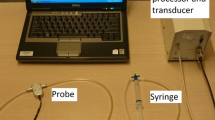Abstract
This study analyzed the relationship between valsalva leak point pressure (VLPP) and maximal urethral closure pressure (MUCP) in women with stress urinary incontinence. One hundred sixty-one patients were selected with diagnosis of mixed or stress urinary incontinence. During urodynamics we measured VLPP and MUCP. Patients were gathered according to VLPP and analysis of variance (ANOVA) was performed. Pearson’s correlation coefficient and linear regression were also utilized. The group with VLPP under 60 cm H2O had mean MUCP of 44.5 cm H20; the group with VLPP between 60 and 90 cm H2O had mean MUCP of 54.3 cm H2O; and the group with VLPP over 90 cm H2O had mean MUCP of 60.1 cm H2O. We observed correlation between MUCP and VLPP when we used Pearson’s correlation coefficient (r=0.22) and linear regression (p<0.05). There was weak correlation between MUCP and VLPP, and MUCP was significantly lower in patients with leak point pressure inferior to 60 cm H2O.

Similar content being viewed by others
References
Bump RC, Coates KW, Cundiff GW, Harris RL, Weidner AC (1997) Diagnosing intrinsic sphincteric deficiency: comparing urethral closure pressure, urethral axis and Valsalva leak point pressures. Am J Obstet Gynecol 177:303–310
Haab F, Zimmern PE, Leach GE (1996) Female stress urinary due to intrinsic sphincteric deficiency: recognition and management. J Urol 156:3–17
McGuire EJ, Fitzpatrick CC, Wan J, Bloom D, Ritchey M, Gormeley EA (1993) Clinical assement of urethral sphincter function. J Urol 150:1452–1454
McGuire EJ, Woodside JR, Borden TA, Weiss RM (1981) Prognostic value of urodynamic testing in myelodysplastic patients. J Urol 126:205–209
Horbach NS, Ostergard DR (1994) Predicting intrinsic urethral sphincter dysfunction in women with stress incontinence. Obstet Gynecol 84:188–192
Swift SE, Ostergard DR (1995) A comparison of stress-leak point pressure and maximal urethral closure pressure in patients with stress incontinence. Obstet Gynecol 85:704–708
Abrams P, Cardozo L, Fall M, et al (2002) The standardisation of terminology of lower urinary tract function: report from the Standardisation Subcommittee of the International Continence Society. Neurourol Urodyn 21:167–178
Sand PK, Bowen LW, Panganiban R, Ostergard DR (1987) The low pressure urethra as a factor in failed retropubic urethropexy. Obstet Gynecol 69:399–402
Appell RA (1997) Sphincter insufficiency: testing and treatment. Curr Opin Urol 7:197–199
Ostergard DR, Bent AE (eds) (1996) Urogynecology and urodynamics: theory and practice, 4th edn. Williams & Wilkins, Baltimore
Sultana CJ (1995) Urethral closure pressure and leak-point pressure in incontinent women. Obstet Gynecol 86:839–842
Theofrastous JP, Bump RC, Elser DM, Wyman RN, McClish DK (1995) Correlation of urodynamic measures of urethral resistance with clinical measures of incontinence severity in women with pure genuine stress incontinence. Am J Obstet Gynecol 173:407–414
Bump RC, Elser DM, Theofrastous JP (1995) Valsalva leak point pressure in women with genuine stress incontinence: reproducibility, effect of catheter caliber, and correlations with others measures of urethral resistence. Am J Obstet Gynecol 173:551–557
Payne CK, Raz S, Barbiaz JW (1994) The Valsalva leak point pressure in the evaluation of stress urinary incontinence: technical aspects of measurement. J Urol 151:478–452
Rud T (1980) The effects of estrogens of the urethral pressure profile in urinary continence and stress incontinent women. Acta Obstet Gynec Scand 59:265–270
Author information
Authors and Affiliations
Corresponding author
Additional information
Editorial Comment: This is a retrospective study of 161 female patients with stress urinary incontinence in which the authors analyze the relationship between urodynamic valsalva leak point pressure (VLPP) and maximal urethral closure pressure (MUCP). In analyzing their data with Pearson’s correlation coefficient and linear regression, the authors found a weak correlation between VLPP and MUCP. In addition, they found a significantly lower MUCP in patients with VLPP less than 60. The authors conclude that MUCP values less than 45 cm H2O are not sensitive in diagnosing intrinsic sphincter deficiency. Although this study supports the known correlation between VLPP and MUCP, it adds little new information to the literature. This subject has previously been studied and evaluated and numerous published articles have already confirmed this correlation. It is already generally accepted that the diagnosis of intrinsic sphincter deficiency should be based on a compilation of factors including patient history, urodynamic, anatomic, and clinical severity criteria
Rights and permissions
About this article
Cite this article
Feldner, P.C., Bezerra, L.R.P.S., de Castro, R.A. et al. Correlation between valsalva leak point pressure and maximal urethral closure pressure in women with stress urinary incontinence. Int Urogynecol J 15, 194–197 (2004). https://doi.org/10.1007/s00192-004-1130-3
Received:
Accepted:
Published:
Issue Date:
DOI: https://doi.org/10.1007/s00192-004-1130-3




